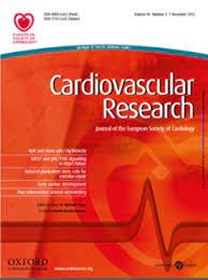心房重构与房颤自我维持:循环circDGCR8的作用
IF 13.3
1区 医学
Q1 CARDIAC & CARDIOVASCULAR SYSTEMS
引用次数: 0
摘要
心房颤动(AF)进展和消融后复发的预测目前基于经验估计,导致预测准确性不理想。本研究探讨心房重构作为影响心房心肌病严重程度的关键因素,是否可以作为影响房颤进展和复发的共同底物。我们旨在鉴定与心房重构相关的环状rna (circRNAs),并评估其预测房颤进展和复发的能力。方法和结果我们使用微阵列分析评估了阵发性(PAF)和持续性AF (PsAF)患者血浆环状rna的差异表达。经过严格的统计和生物信息学分析,通过qPCR验证选定的候选环状rna。与PAF患者相比,circDGCR8在PsAF中一致被发现上调。此外,circDGCR8在血管紧张素II (AngII)处理的人心房成纤维细胞中显著上调。功能获得和功能丧失研究表明,circDGCR8可以通过促进胶原生成和成纤维细胞增殖,在细胞水平上促进心房重构。circDGCR8在人心脏成纤维细胞中的过表达显著改变了基因表达谱,影响包括IL-17信号通路和TNF信号通路。此外,circDGCR8水平与心房纤维化呈正相关,如低压区百分比增加所示。circDGCR8的预测价值在两个队列中进行了评估:(i)以进展为PsAF的PAF患者监测36个月,以及(ii)接受射频消融的AF患者随访12个月以评估复发。在这两个队列中,较高水平的circDGCR8与房颤进展和消融后复发的风险增加相关。我们的研究结果表明,与心房重构相关的circDGCR8具有作为房颤进展和消融后复发的预测性生物标志物的潜力。本文章由计算机程序翻译,如有差异,请以英文原文为准。
Atrial remodelling and atrial fibrillation self-sustaining: the role of circulating circDGCR8
Aims The prediction of atrial fibrillation (AF) progression and post-ablation recurrence is currently based on empirical estimates, leading to suboptimal predictive accuracy. This study investigates whether atrial remodelling, a key factor in the severity of atrial cardiomyopathy, could serve as a shared substrate influencing both AF progression and recurrence. We aimed to identify circular RNAs (circRNAs) associated with atrial remodelling and to evaluate their ability to predict AF progression and recurrence. Methods and results We assessed the differential expression of plasma circRNAs between paroxysmal (PAF) and persistent AF (PsAF) patients using microarray analysis. Selected candidate circRNAs were validated through qPCR following rigorous statistical and bioinformatics analysis. circDGCR8 was consistently found to be up-regulated in PsAF compared with PAF patients. Additionally, circDGCR8 was significantly up-regulated in human atrial fibroblasts treated with angiotensin II (AngII). Gain- and loss-of-function studies suggested that circDGCR8 could promote atrial remodelling at cellular level by enhancing collagen production and fibroblast proliferation. Overexpression of circDGCR8 in human cardiac fibroblasts significantly altered the gene expression spectrum, impacting pathways including IL-17 signalling and TNF signalling. Moreover, circDGCR8 levels were positively correlated with atrial fibrosis, as indicated by increased percentages of low voltage zones. The predictive value of circDGCR8 was evaluated in two cohorts: (i) PAF patients monitored for 36 months with progression to PsAF as the endpoint, and (ii) AF patients who underwent radiofrequency ablation followed for 12 months to assess recurrence. In both cohorts, higher level of circDGCR8 was associated with increased risks of AF progression and post-ablation recurrence. Conclusion Our results suggest that circDGCR8, associated with atrial remodelling, holds potential as a predictive biomarker for both AF progression and post-ablation recurrence.
求助全文
通过发布文献求助,成功后即可免费获取论文全文。
去求助
来源期刊

Cardiovascular Research
医学-心血管系统
CiteScore
21.50
自引率
3.70%
发文量
547
审稿时长
1 months
期刊介绍:
Cardiovascular Research
Journal Overview:
International journal of the European Society of Cardiology
Focuses on basic and translational research in cardiology and cardiovascular biology
Aims to enhance insight into cardiovascular disease mechanisms and innovation prospects
Submission Criteria:
Welcomes papers covering molecular, sub-cellular, cellular, organ, and organism levels
Accepts clinical proof-of-concept and translational studies
Manuscripts expected to provide significant contribution to cardiovascular biology and diseases
 求助内容:
求助内容: 应助结果提醒方式:
应助结果提醒方式:


